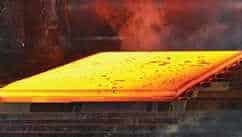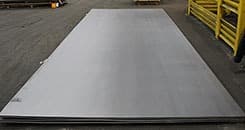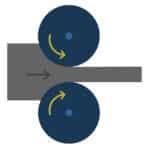What’s the Difference between Hot Rolled Steel and Cold Rolled Steel?
Hot rolled, cold rolled, cold drawn, cold finished? A lot of similar words you may hear, but what are they and what’s the difference? Many people call into Clifton Steel asking our veteran sales staff these very same questions. In short, the difference between hot rolled steel and cold rolled steel is the processing temperature. Hot rolled steel is, you guessed it, processed at a hot (semi-molten state) temperature. Cold Rolled steel starts with hot rolled steel and is further refined by processing at room temperature.
Hot Rolled Steel
The nice thing about steel is that it’s a fairly logical commodity. The names commonly used in the industry tend to tell users how it was made. Hot rolled steel is a prime example. As we said above, hot rolled steel is manufactured in a semi-molten state, which allows it to be formed into many different shapes. The term hot rolled can be used to refer anything from bar stock to sheet and plate. It means that the process used by the manufacturing steel mill takes place while the steel is semi-molten. The semi-molten state allows the mill to easily manipulate it into the shape and dimension desired for production.
hot rolled steel plate, hot molten steel, hot steel Hot rolled bar process: hot steel is processed (or rolled) in open air in a semi-molten state, where the surface of the steel, through processing, becomes semi-hardened and the core of the strand is still red hot and malleable. Might sound confusing, but think of it as a 3 Musketeers bar: the outside chocolate is harder than the inside chocolate, but not by much. This process typically leaves the surface of the steel with a layer of carburization (or what some call “mill scale”). The surface is rough to the touch, and almost always requires further processing to make it a finished good.
Hot rolled bar process: hot steel is processed (or rolled) in open air in a semi-molten state, where the surface of the steel, through processing, becomes semi-hardened and the core of the strand is still red hot and malleable. Might sound confusing, but think of it as a 3 Musketeers bar: the outside chocolate is harder than the inside chocolate, but not by much. This process typically leaves the surface of the steel with a layer of carburization (or what some call “mill scale”). The surface is rough to the touch, and almost always requires further processing to make it a finished good.
Hot rolled products require less processing from the producing mill and, in general, are more affordable compared to cold rolled steel.
 The same explanation can be used to describe hot rolled sheet and hot rolled plate. The semi-molten slab of steel is rolled back and forth between large rollers in open air in order to reduce the thickness into the desired size. Hot rolled sheets and plates also have an external scale that usually needs to be removed by further processing. Ask us about our in house shot blasting service to aid in the removal of hot rolled mill scale! Exceptions to this would include applications in structural components or in the use of Abrasion Resistant plate (like our Tensalloy AR series plate).
The same explanation can be used to describe hot rolled sheet and hot rolled plate. The semi-molten slab of steel is rolled back and forth between large rollers in open air in order to reduce the thickness into the desired size. Hot rolled sheets and plates also have an external scale that usually needs to be removed by further processing. Ask us about our in house shot blasting service to aid in the removal of hot rolled mill scale! Exceptions to this would include applications in structural components or in the use of Abrasion Resistant plate (like our Tensalloy AR series plate).
Most hot rolled products require additional processing (e.g. machining) to remove the mill scale and produce a finished product. Hot rolled products are typically produced with a +/- dimension tolerance to account for that.
Cold Rolled Steel
Cold rolled steel also gets its name from how the steel is processed. That means that the steel is processed at, or near, room temperature as opposed to the semi-molten temperature for hot rolled steel. Most cold rolled products begin their lives as hot rolled products, then are further processed to create the benefits of cold rolled steel. So, what are the benefits of cold rolled steel?
I’m glad you asked. The benefits of cold rolled steel can be broken down into three main categories:
- Mechanical properties
- Dimensional tolerance
- Surface finish
While there are many types of cold rolling processes, we’ll focus on cold drawing and cold finishing of bar products and cold rolling of sheet products.
Cold Drawing
Cold drawing is utilized to improve the mechanical properties of steel bar products. The hot rolled steel is drawn through a sequence of reducing dies or rollers that cold-work the steel into a strand hardened form, improving mechanical properties. It also allows the processor to greatly improve the dimensional tolerance of the product being made. In this instance, the dimensional tolerances are usually produced to a minus only tolerance with the expectation that there will be much less need for additional surface processing to create that finished product. Although cold drawn bar is initially more expensive than hot rolled bar, overall cost savings is provided by the reduced machining generally required.
Cold Finishing
Cold finishing bars, on the other hand, do not improve the mechanical properties of the steel. For cold finishing, hot rolled bar is turned, turned & polished, or turned, ground, & polished producing a shiny, semi-finished surface. This finishing can achieve much tighter dimensional tolerances, allowing customers to utilize the product as-is or with minimal additional processing. An advantage of cold finishing is that it minimizes machining time, giving customers a more cost-effective finished product. Cold finished products are also produced typically to minus only dimensional tolerances. In order of tightness of tolerance from largest to tightest: turned bar, turned & polished, turned, ground & polished. A good example of a cold finished bar product would be our hammer pins for the recycling industry. These utilize a proprietary dimensional tolerance allowing for ease of replacement.
Cold Rolling
 Cold rolling of steel sheet products is the only true sense of “rolling” in the cold rolled steel universe. More often cold rolled steel products are referred to as cold rolled, but in actuality they are turned or drawn. In the case of cold rolled sheet products, the finishing process is the only processing that is actually rolled. A hot rolled sheet product is processed through a series of rollers that gradually reduce the thickness of the steel while simultaneously removing some of the hot rolled mill scale. This process strain hardens the steel which produces mechanically stronger physical properties in the steel. It also improves the surface finish of the steel making it closer to a finished product.
Cold rolling of steel sheet products is the only true sense of “rolling” in the cold rolled steel universe. More often cold rolled steel products are referred to as cold rolled, but in actuality they are turned or drawn. In the case of cold rolled sheet products, the finishing process is the only processing that is actually rolled. A hot rolled sheet product is processed through a series of rollers that gradually reduce the thickness of the steel while simultaneously removing some of the hot rolled mill scale. This process strain hardens the steel which produces mechanically stronger physical properties in the steel. It also improves the surface finish of the steel making it closer to a finished product.